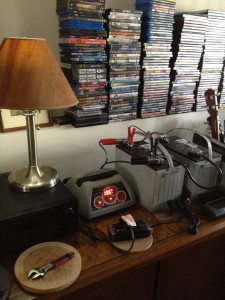Well, today I am sharing my battery back-up power system. I knew we needed something like this, and have had to use it a number of times when we’ve lost power due to the frequent thunderstorms here in Minnesota. I can’t take credit for having developed this, though I did put it together. I was fortunate to have learned how to do this, step by step, from Steven Harris http://www.Battery1234.com and Jack Spirko http://www.thesurvivalpodcast.com/ , both of which are wonderful resources!
I used pretty much the best batteries I could find for this purpose, choosing two AGM marine deep-cycle batteries. These are totally sealed and unless you break open the case, or drop one on your foot, they are quite safe for indoor use. The Shumacher 100 amp charger stays hooked up at all times, which keeps the batteries topped off, and really uses very little power. I have a small inverter hooked up to the system, and keep a low power LED light running off of it, as in indicator that the system is functioning appropriately.
This system will allow you to run DC items directly from the batteries, or AC items off of the inverter(s). I have a number of inverters from the little 100 watt one shown up to a 2500 watt version for running more stuff, or higher draw items. Being that the inverters put out AC power, which can go much further, we can run extension cords to wherever in the house we need power. The DC power is very efficient, but only when used in close proximity to the batteries.
Keep in mind that you won’t be able to power your fridge or monster flat screen TV and DVR, at least not for very long with this system. This is intended to keep lights on, maybe a couple of fans, a small TV & DVD player or laptop and maybe a few other low draw items. The key here is to use only low draw items to extend your run time. I have a small 7″ LCD TV/VCR combo, and a couple of small fans, and we use only LED bulbs for our emergency lighting. I have found LED bulbs that draw as little as 1/2 watt, but put out the equivalent of a 15 watt incandescent bulb.
One thing this system will also allow you to do is to charge batteries for your cell phones, the kids games, flashlights & battery operated lanterns or whatever. You can charge these types of items quite a few times off of the big batteries, hopefully keeping you connected and informed! Steven recommended, and I bought, Sanyo Eneloop rechargeable batteries and a Powerex charger that will charge anywhere from 1 to 8 AA or AAA batteries, in any combination or quantity, in just 2 hours.
it’s possible to get quite a few hours (maybe days) of power, using low draw items like I’ve described, from the 2 batteries you see in our system. If power stays out for a longer period of time, it’s a simple matter to take the batteries outside and hook them up to charge them from your car or truck. You definitely want to run the vehicle while you do this, but it gives you the ability to keep lights & some essential items going for days at a time, while your neighbors are in the dark.
My next project is to make a duplicate of this system for use on the upper floor of our house, to avoid having to run extension cords upstairs. Later, I intend to add in a solar panel, and charge controller to allow for yet another means of charging.
This is just a quick overview, and I hope it has piqued your interest. This has made our lives much more comfortable through several power outages already, and I highly recommend putting one together. If you want to put together a system like this I highly recommend you visit Steven Harris’ site at the link above, and either buy his DVD with several battery backup projects, or at least to listen the the Survival Podcast shows with Jack, on battery power systems.
I have to tell you, it seriously rocks to have this kind of backup power, and I hope you decide to give this project a try.
Till next time, keep doing!
Mike
